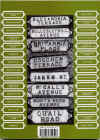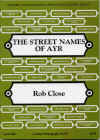

Rob Close, The Street Names of Ayr, (AANHS, Ayr, 2001), ISBN 0 9527445 9 7, £5.00, 136 pages.
 |
 |
The need to name things and places is deep–seated in the human psyche. The desire to know what names mean is likewise basic. Most folk also want to know why a name was given and when.
Hence the fascination of books like Johnston’s The Place Names of Scotland, and their lasting popularity.
Street names in towns have only recently in the history of mankind assumed any importance, for during most of urban history not all streets had names, and none had numbers; informal addresses sufficed, and people took directions from notable buildings like the Harbour Bar or Matha Dickie’s. In a town like York some people still navigate by medieval churches, some still by public houses; this summer, however, my wife nominated the place at which I was to meet her as Dutton’s for Buttons.
As Rob Close informs us in the foreword to this wonderfully comprehensive book, it was in 1828 that the town council of Ayr resolved "to place the name of each street and lane in large painted cpaitals on the entries or corners thereof, and to number the houses."
From that date our author gives gives us chapter and verse for every new name approved by the council. What a joy it is to see in a local history publication myriads of footnotes, for each of Close’s assertions is vouched not only by a reference to minutes of the Council and of its various committees but to newspapers and other published works, and old maps. For example, Crown Street was so named in 1922, presumably, according to Close, "to give the street a tone not conveyed by the superseded name." The whole debate about the proposed change from the former name, Clunes Vennel, appears in an amusing footnote. Provost Mathie–Morton, who was against any change, "could not see how a murder [which had been committed in the Vennel a couple of years before] should affect the letting of houses or rooms in the street," and as for changing from Vennel because it was old–fashioned there was as much sense in changing the name "Wellington Square" to "Pavilion Square."
It is traditional to allow a reviewer to find at least one fault. I have been unable to find in this otherwise excellent book any reference to Smith’s Close, of which I have an excellent engraving by the Ayr artist, T. Bonar Hone, and of the location of which I am still ignorant.
When Rob Close’s book, Ayrshire & Arran, An Illustrated Architectural Guide, appeared in 1992, I expressed the view in print that I would never be without it as I travelled around the county. No one with even the slightest interest in the history of Ayr should be without The Street Names of Ayr as he or she goes around the town.
David B Smith